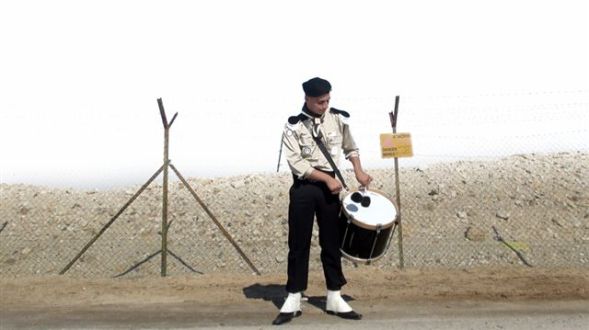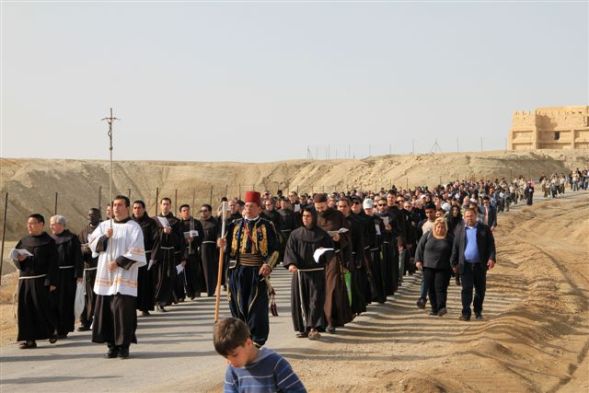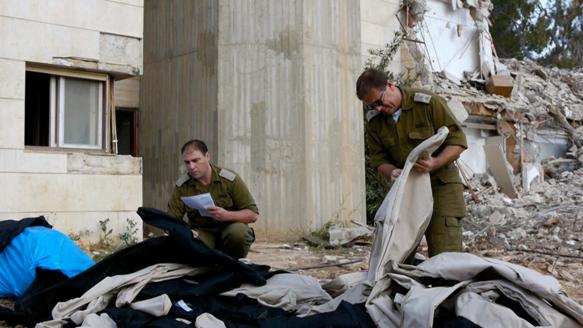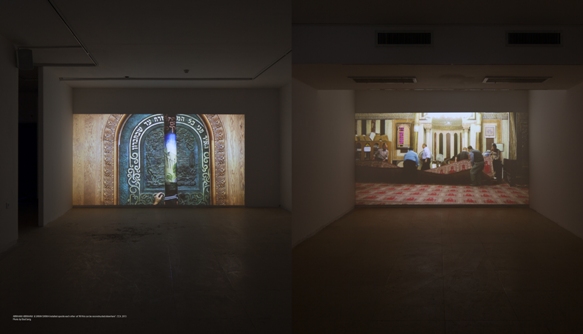
Video art came of age in this country in 2011 when Nira Pereg, a young Israeli video artist, was awarded Tel Aviv Museum’s Gottesdiener Foundation prize. This was an honor for Pereg, but also her selection for this prize may be viewed as the art establishment’s way of placing this medium on equal footing with painting and sculpture, acknowledging its power and possibilities.
Pereg, is showing four new installations at this Tel Aviv venue. All of them, influenced by the cinema, documentary or nature films, were produced by complex editing techniques. They focus, as her most recent work has done, on rituals and behavior unique to Israeli life.
As this is the case, All of This can be Reconstructed Elsewhere, the overall title given to this show can be viewed as an ironic statement. Pereg quoted these words from a conversation that Italian film director Pier Paolo Pasolini held with a priest during the production of “A Visit to Palestine,” a film he made documenting his search for locations in Jordan and Israel for the film The Gospel according to St. Matthew (1964), eventually shot in southern Italy.

Random comments by Pasolini as he was surveying the dusty landscape and “gloomy heat,” are included as snippets of text in Pereg’s five-channel video Mandatory Crossing. Like all her work, this installation is an impressive collage of images, interviews, photos and sounds. It was shot over a five month period at the historical site of Qasr el Yahud, on the banks of the Jordan River, where Jews believe that the tribes of Israel crossed into the Holy Land after 40 years in the wilderness; and which Christians identify as the place where Jesus was baptized by John the Baptist.
This site, once a nature reserve, was declared a closed military area after the Six Day war. Flanked by minefields, only a three kilometer passage was left open for the passage of hundreds of Christian pilgrims. Pereg has manipulated their movement so that they appear to be walking forward and then stepping backwards, as if unable ever to reach their destination. A young drummer, the sound of whose beat fills the gallery, is at the forefront of this procession. Pereg has also filmed pilgrims entering the Jordan River to be baptized, and – a strange detail – filling plastic bottles with ‘holy water’. Also documented are stretches of empty, dusty landscape (just as described by Pasolini), as well as some beautiful imagery of the nocturnal life of the creatures that still inhabit this area.

A routine army procedure, that of preparing a supposedly collapsed building for emergency evacuation after a disaster is featured in the video Scenario (2012). In this non-too-clear narrative, soldiers are shown laying down dummy bodies, sealing the area off with security tape, and then, inexplicably, removing these bodies, counting them, and placing them outside in a heap.

The mirror videos Abraham –Abraham Sarah- Sarah, documenting a strange event that takes place ten times a year in the Tomb of the Patriarchs, proves to be a most fascinating work. This cave, a place of worship for both Jews and Muslims, has been divided for separate use since 1994 when Baruch Goldstein opened fire on Palestinian worshippers. But, at special times of the year, each group is given use of the whole space for 24 hours. Pereg has photographed this extraordinary change-over. First, the Jewish congregants clear the area of all their religious artifacts and leave the building, turning it over for military inspection. The Muslim worshippers then enter the cave and set up a mosque. No one speaks, there are only the sounds of people working, laying down prayer rugs, putting up pictures, and dragging in furniture.
With this absorbing work, Pereg continues, most effectively, to throw light on unique ‘corners’ of Israeli life. Contrary to film director Pasolini’s statement, nothing that she focuses on could be reconstructed elsewhere. Only in Israel.
This exhibition curated by Sergio Edelsztein is open until April 10th, 2013.
The Center for Contemporary Art, 5 Kalisher St. Tel Aviv. Tel. for opening hours: 03 5106111.





